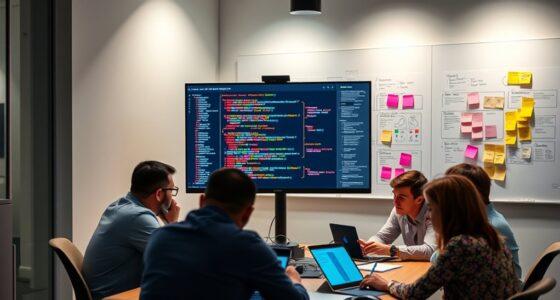Containers use Linux kernel features like cgroups and namespaces to create isolated, lightweight environments. Cgroups control and limit resources such as CPU, memory, and I/O, ensuring containers don’t compete unfairly or overload the system. Namespaces provide separate views of network, processes, and filesystems, making each container appear independent. Together, these features form the core of container technology, enabling secure, efficient, and portable application environments. Keep exploring to uncover how these components work seamlessly behind the scenes.
Key Takeaways
- Containers use Linux kernel features like cgroups and namespaces to isolate resources and processes efficiently.
- Cgroups limit CPU, memory, and I/O usage to ensure predictable container performance.
- Namespaces provide separate network stacks, filesystem views, and process IDs for each container.
- Together, cgroups and namespaces create virtual environments that appear independent from the host system.
- These kernel features enable lightweight, portable, and consistent container deployment across different environments.

Containers have revolutionized how you develop, deploy, and manage applications by providing a lightweight, portable environment that runs consistently across different systems. At the core of this technology are mechanisms that guarantee each container operates independently and efficiently, without interfering with others. Two of the most critical components enabling this are resource isolation and process management. These features are made possible by underlying Linux kernel features called cgroups and namespaces, which work together to create a virtualized environment within a single host system.
Resource isolation is essential because it ensures that containers don’t compete for system resources like CPU, memory, disk I/O, or network bandwidth. Cgroups, short for control groups, are responsible for this task. They allow you to allocate, prioritize, and limit resources for each container, preventing any single container from monopolizing system resources and affecting others. For example, you can set a maximum CPU usage for a container or cap its memory consumption, ensuring predictable performance and avoiding system overloads. This fine-grained control helps maintain the stability and efficiency of your infrastructure as multiple containers run simultaneously. Understanding how resource allocation works is crucial for optimizing container performance and security.
Cgroups manage and limit container resources, ensuring stable, predictable performance across multiple containers.
Process management is equally crucial, and it’s primarily handled by Linux namespaces. Namespaces provide isolated views of system resources, so each container perceives a separate environment. For instance, network namespaces give each container its own network stack, including IP addresses and routing tables, making it appear as if each container runs on its own isolated network. Likewise, process namespaces hide the processes inside a container from the host and other containers, ensuring that processes inside one container can’t see or interfere with those in another. This isolation extends to filesystem views, user IDs, and hostnames, creating a complete virtual environment that appears independent from the host system and other containers.
Together, cgroups and namespaces form the backbone of container technology. They enable process management by controlling how processes are spawned, executed, and isolated, while resource isolation guarantees that containers are confined within their allocated limits. As you deploy containers, understanding these underlying mechanisms helps you optimize performance, troubleshoot issues, and guarantee security. You gain the ability to fine-tune resource allocation, monitor container activity, and enforce boundaries that keep your applications running smoothly. This synergy of resource isolation and process management ensures containers remain lightweight, portable, and consistent, making them an indispensable tool for modern application deployment.
Frequently Asked Questions
How Do Cgroups Impact Container Resource Management?
Cgroups impact your container resource management by enabling container resource isolation, ensuring each container gets its designated CPU, memory, and I/O limits. This improves cgroups performance by preventing resource contention and overuse, which helps maintain stability and efficiency. With cgroups, you can fine-tune resource allocation, making sure your containers run smoothly without affecting each other, ultimately optimizing overall system performance.
What Are the Security Implications of Linux Namespaces?
You should know that Linux namespaces create strong security boundaries through namespace isolation, which limits a process’s view of the system. However, if misconfigured, they can expose vulnerabilities, allowing potential escape or privilege escalation. Properly managed, namespaces enhance security by segregating resources and processes, but neglecting their configuration could undermine your system’s security. Always guarantee namespaces are correctly set up to maintain effective security boundaries.
Can Containers Share Namespaces Across Different Hosts?
You can’t share namespaces across different hosts directly. Cross-host namespace sharing isn’t supported because namespaces are confined to a single kernel instance on one machine. This limitation affects container network isolation, making it challenging to maintain consistent network environments across multiple hosts. To achieve cross-host communication, you typically use overlay networks or other networking solutions, but these don’t provide true namespace sharing—they just simulate it for container connectivity.
How Do Cgroups Differ From Traditional Linux Process Limits?
Cgroups differ from traditional Linux process limits by offering more advanced process isolation and resource throttling. Instead of just setting limits on individual processes, cgroups allow you to group processes and control their combined resource usage—CPU, memory, I/O, and more. This way, you prevent any container or process group from overusing resources, ensuring better system stability and efficient resource management across multiple containers or processes.
What Tools Are Available for Monitoring Container Resource Usage?
Imagine your container’s resource utilization like a dashboard in your car; monitoring tools give you real-time insights. Tools like Prometheus, Grafana, and cAdvisor track CPU, memory, and network usage, helping you spot issues quickly. You can also use Docker stats or Kubernetes dashboards for quick checks, ensuring your containers run smoothly. These monitoring tools empower you to optimize resources and prevent bottlenecks before they impact performance.
Conclusion
So, next time you marvel at those sleek containers, remember they’re just clever illusions hiding a complex web of cgroups and namespaces. It’s funny how something so lightweight can pack such a punch, isn’t it? Just think—while you’re enjoying seamless apps, underneath, a tiny army is working tirelessly behind the scenes. It’s almost poetic how these tiny tech miracles keep everything running smoothly, all while you take the credit for the magic.








